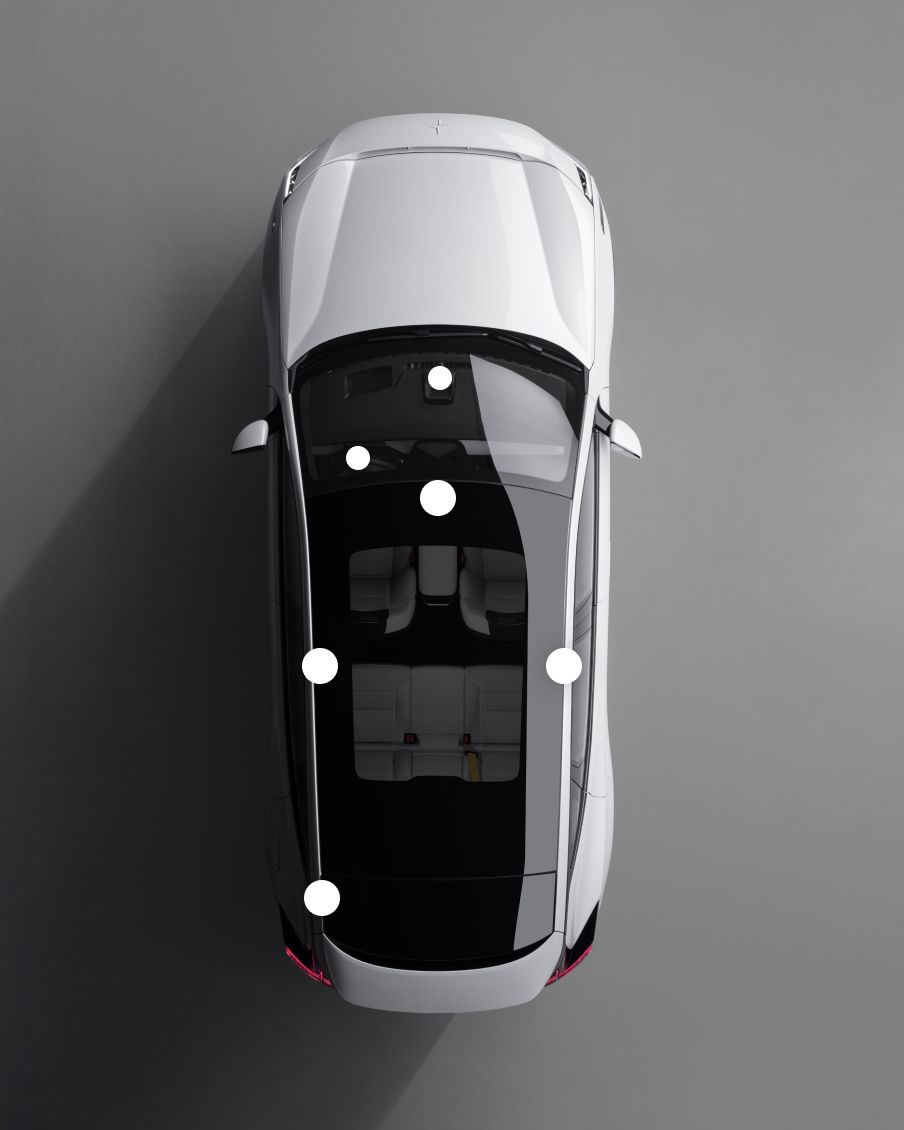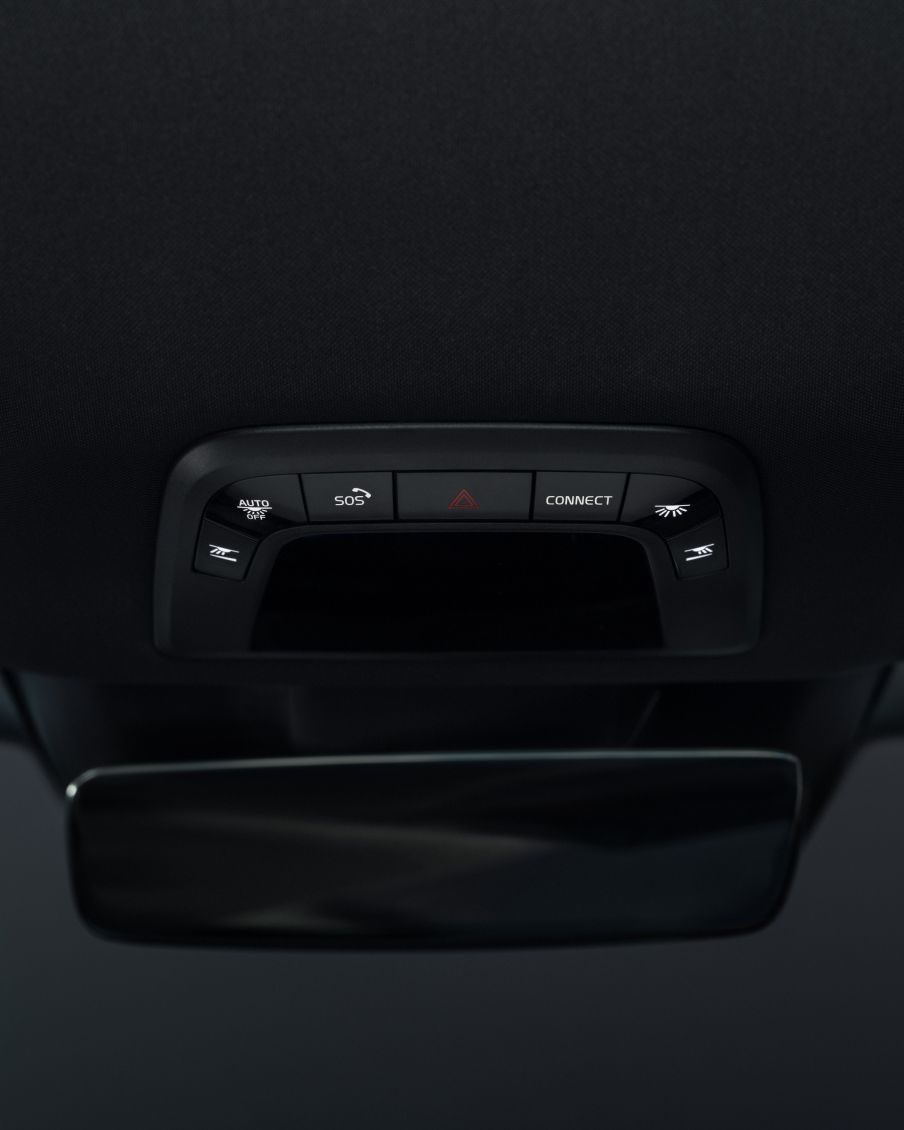- Ytra byrði
- Innanrými
- Eiginleikar
- Drægni og hleðsla
- Upplýsingar og afþreying
- Öryggi
- Forvarnar- og verndartækni
- Vélbúnaður og skynjarar
- Ökumannseftirlitskerfi
- Farþegaskynjunarkerfi
- Blindpunktsaðvörun (Blind Spot Information System)
- Árekstrarvari að framan
- Akreinavari
- Bílastæðaskynjarar og aðstoð
- Adaptive Cruise Control with steering assistance
- Road Sign Information
- Snjöll lýsing
- Hljóðviðvörunarkerfi ökutækis
- Vernd eftir árekstur
- Gagnlegur aukabúnaður
- Sjálfbærni
- Að eiga Polestar 3
- Viðbótarbúnaður
Öryggi
Forvarnar- og verndartækni
Vegna þess að Polestar og Volvo Cars deila tæknilegri sérþekkingu, byggir Polestar 3 á næstum því 100 ára byltingarkenndri þróun í öryggi. Bíllinn er hannaður með nýjustu uppfinningum í uppbyggingu til að verja farþega sína, á meðan háþróuð skynjaratækni hjálpar til við að hindra árekstra, og verja berskjaldaða vegfarendur eins og gangandi vegfarendur og hjólreiðamenn.

Vélbúnaður og skynjarar
Tólf úthljóðsskynjarar, fimm ratsjár, fimm myndavélar, tveir ökumannseftirlitsskynjarar, fjórar innri ratsjár. Umtalsverð vinnslugeta um borð umbreytir skynjaragögnum í fyrirbyggjandi viðvaranir, og grípur inn í þegar nauðsyn krefur.
SmartZone: Frá því að anda til þess að sjá
Í hefðbundnum bílum andar vélin í gegnum grillið. SmartZone framan á Polestar 3 er með ratsjá og myndavél sem gera bílnum kleift að sjá. Með skynjurum sem fylgjast með hættulegum aðstæðum er bíllinn meðvitaður um umhverfi sitt með það markmið að farþegarnir og aðrir vegfarendur séu alltaf öruggir.

Ratsjár og myndavélar í innanrými
Háþróaðar myndavélar og ratsjárskynjarar innan í Polestar 3 fylgjast með ökumönnum og farþegum. Það eru tvær innrauðar augnmælingarmyndavélar í mælaborðinu, auk fjögurra 60 GHz ratsjáa sem greina hreyfingar. Ratsjárkerfið er það fyrsta af sinni tegund sem nær yfir allt innanrými bílsins, þ.m.t. farangursrýmið að aftan.
LiDAR from Luminar
Greindu hluti sem eru í allt að 250 metra fjarlægð og fáðu aukna eiginleika fyrir akstursaðstoð í myrkri og almennt slæmum skilyrðum, þökk sé hinni öflugu 1550 nm bylgjulengd. LiDAR einingunni fylgja til viðbótar tvær 8 megapixla baksýnismyndavélar og ein 8 megapixla langdræg myndavél, auk sjálfvirks hreinsunareiginleika og aðaltölvu frá NVIDIA til viðbótar.
Fáanlegt með Pilot pakkanum með LiDAR.
Ökumannseftirlitskerfi
Tvær innrauðar augnrakningarmyndavélar fylgjast með augnlokum ökumanns, augnaráði og höfuðhreyfingum. Ef kerfið greinir að ökumaður sé syfjaður eða annars hugar, virkjar það hljóð- og sjónviðvaranir. Í tilfelli skyndilegs veikinda eða meðvitundarleysis, framkvæmir kerfið neyðarstöðvun. Myndavélarnar geyma ekki né deila því sem þær sjá.

Occupant Detection System
Forðastu að skilja barn eða gæludýr eftir í bílnum fyrir slysni. Þegar Polestar 3 er læst, athuga fjórar innri radarar hreyfingu í öllu farþegarýminu, þar með talið í farangursrýminu að aftan. Ef jafnvel minnstu hreyfingar eru greindar, kemur kerfið í veg fyrir að bíllinn læsist og birtir áminningu, auk þess að gefa frá sér hljóðviðvörun ef ökumaðurinn er að ganga í burtu. Ökumenn geta samt valið að læsa bílnum í gegnum miðskjáinn. Þetta heldur einnig loftkerfi bílsins virku, sem bætir þægindi og hjálpar til við að draga úr hættu á ofkælingu eða hitaslagi.

Blindpunktsaðvörun (Blind Spot Information System)
Ef ökutæki er að fara fram úr Polestar 3, varar blindpunktsaðvörunin (Blind Spot Information System) ökumanninn við með viðvörunarljósi innbyggðu í rammalausu speglana. Ef kerfið skynjar að ökumaðurinn ætli að skipta um akrein beinir stýrisstuðningurinn Polestar 3 aftur á akreinina sína.
Árekstrarvari að framan
Dag eða nótt, við öll skilyrði, vaktar Polestar 3 umhverfið í kring með röð af skynjurum og háþróaðri tækni. Hann varar ökumanninn við þegar greindir eru gangandi vegfarendur, hjólreiðamenn eða umferðarfrávik við gatnamót. Ef ökumaðurinn hemlar ekki tímanlega þá hemlar bíllinn sjálfkrafa til að koma í veg fyrir eða draga úr áhrifum hugsanlegs áreksturs.
Akreinavari
Veglínuskynjari
Ef veglínuskynjarinn (Lane Keeping Aid) greinir að bíllinn sé að fara að skipta um akrein án þess að nota stefnuljósin stýrir hann bílnum mjúklega aftur á akreinína. Ef þetta lagar ekki vandamálið er ökumanninum gert viðvart með titringi í stýrinu.
Akreinavari
Útafakstursvörn
Gúmmíinu haldið á veginum. Ef Polestar 3 leitar í átt að vegöxlinni þá aðstoðar útafakstursvörnin (Run-off Road Mitigation) við að stýra bílnum tilbaka. Ef bíllinn fer samt út af yfirborði vegarins beitir bíllinn hemlunum og undirbýr öryggisbeltin fyrir mögulegan árekstur.
Bílastæðaskynjarar og aðstoð
Polestar 3 notar myndavélar sínar og skynjara til að hjálpa til við leiðsögn þegar farið er inn í og út úr bílastæðum, inn í þröng stræti og fyrir horn. Bíllinn varar ökumanninn við hugsanlegum hættum, og getur einnig gripið til fyrirbyggjandi aðgerða þegar þess þarf.
360° og baksýnismyndavélar
Við tilfærslur sýnir Polestar 3 umhverfi sitt úr lofti. Bílastæðahjálp notar 360° úthljóðsskynjara og myndavél með fiskaugalinsu til að mæla fjarlægðina frá hindrunum framan og aftan við bílinn, og varar ökumanninn við með mynd og hljóði að hann þurfi að afstýra árekstri.
Umferðarskynjari að aftan (Cross Traffic Alert) með sjálfvirkri hemlun
Þegar bakkað er út úr innkeyrslu, bílastæði eða fyrir horn, notar Polestar 3 umferðarskynjarinn að aftan (Cross Traffic Alert) afturratsjárnar til að skanna eftir bílum, hjólreiðamönnum og gangandi vegfarendum sem nálgast. Í kjölfar viðvarana með mynd og hljóði virkjast sjálfvirk hemlun til að stöðva ökutækið ef það er hætta á árekstri.
Sjálfstýringarbúnaður til að leggja bílnum
Sjálfstýringarbúnaðurinn til að leggja bílnum (Park Assist Pilot) gerir Polestar 3 kleift að greina hentug bílastæði á hraða allt að 30 km/klst. og stýra sér sjálfur inn í það sem valið er á miðjuskjánum. Kerfið ræður við að leggja í stæði sem eru samsíða, hornrétt eða á ská, svo lengi sem ökumaðurinn er til staðar.
Fáanlegt sem uppfærsla.
Adaptive Cruise Control with steering assistance
Farðu með straumnum. Aðlögunarhraðastillir fylgist með hraða og fjarlægð ökutækja fyrir framan og stillir hraða Polestar 3 í samræmi við það. Þessi eiginleiki virkar á allt að 150 km/klst hraða.
Pilot Assist
Pilot Assist veitir afslappaðri akstursupplifun á hraðbrautum og aðalvegum. Þegar ökumaðurinn hefur valið hraðann og tímabilið að næsta ökutæki á undan, vaktar Pilot Assist fjarlægðina að ökutækinu á undan og akreinamerkin, og gerir sjálfvirkar breytingar á hraða og stýringu til að viðhalda æskilegri staðsetningu.
Fáanlegt sem uppfærsla.
Akreinaskiptisaðstoð
Þegar Pilot Assist er virkt getur Polestar 3 einnig skipt um akrein sjálfkrafa. Með því að færa stefnuljósstöngina alveg upp eða niður hefst aðgerðin, og bíllinn mun aðeins halda áfram ef skynjarar kerfisins gefa til kynna að það sé öruggt.
Fæst sem uppfærsla
Upplýsingar um umferðarskilti
Bíll sem sér skiltin. Jafnvel þegar ökumaðurinn gerir það ekki. Upplýsingarkerfi fyrir umferðarskilti greinir og sýnir hraðatakmörk og önnur umferðarskilti á mælaborðinu.
Snjöll lýsing
Hin nýja kynslóð LED-aðalljósa Polestar 3 getur sjálfkrafa skipt á milli lág- og háljósa. Styrkur geislans er stöðugt aðlagaður til að fá bestu lýsingu óháð farminum sem bíllinn ber. Valkvæðu 1.3 Megapixel HD LED-aðalljósin gera aksturinn öruggari og afslappaðri, með því að veita ótakmarkaða möguleika til að aðlaga dreifinguna ljóssins að birtu-, veður- og umferðarskilyrðum.
1.3 megapixel HD LED
Megapixla tæknin sem notuð er í háskerpu LED-aðalljósunum aðlagar sjálfkrafa dreifingu geislans að umhverfi bílsins. Stýrt af myndavélum draga 1,3 milljón pixla einingarnar í hverju ljósi úr glampa með því að skyggja út ökutæki sem koma úr gagnstæðri átt eða aka á undan og skær umferðarskilti, og beina geislanum þangað sem hans er þörf.
Fáanlegt sem uppfærsla.
Virk háljós
Hið háþróaða kerfi fyrir virkan hágeisla greinir bæði umferð úr gagnstæðri átt og bíla sem eru fyrir framan Polestar 3, og skiptir sjálfkrafa í lággeisla til að forðast að blinda aðra ökumenn.
Viðvörunarröð afturljósa
Með Polestar 3 er unnið á virkan hátt að því marki að auka öryggi allra ökumanna. Ef þrýst er mjög snöggt á hemlafetilinn skynja kerfin um borð hugsanlegt neyðartilvik og afturljósin sýna sjálfkrafa viðvörunarljósaröð.
Hljóðviðvörunarkerfi ökutækis
Kurteis leið til að láta gangandi vegfarendur og hjólreiðamenn vita að Polestar 3 sé að nálgast eða bakka. Með þremur ytri hátölurum myndar hljóðviðvörunarkerfi bílsins (AVAS) einstök, auðkennandi hljóð sem hjálpa bílnum við að láta heyra í sér, sem eykur öryggið fyrir berskjaldaða vegfarendur.
01/02
Vernd eftir árekstur
Vel hönnuð yfirbygging er grundvallaratriði þegar kemur að öryggi. Farþegarými Polestar 3 er búið 9 loftpúðum, og byggð úr ofursterku stáli. Krumpusvæði bílsins að framan og aftan nota blöndu efna til að gleypa í sig og dreifa orku, og vernda þannig farþegana við árekstraraðstæður.

Hemlun í kjölfar áreksturs
Hemlun eftir árekstur (Post-impact braking) dregur úr hættunni á alvarlegum meiðslum eða skemmdum á bílnum, auk alvarleika hugsanlegs seinni áreksturs. Þegar loftpúðarnir og beltastrekkjararnir eru virkjaðir við árekstur, gefa skynjararnir um borð hemlunum merki um að fara með bílinn í stýrða kyrrstöðu, sem dregur úr eftirköstum árekstursins.

Bein aðstoð
Toppstjórnborðið inniheldur tvo hnappa fyrir beina hringingu í tilviki bilunar eða slyss. Tengja-hnappurinn er notaður til að ná í Polestar aðstoð vegna atburða eins og tómrar rafhlöðu eða sprungins dekks. SOS-hnappurinn er ætlaður fyrir neyðartilvik eins og slys. Í tilviki alvarlegs slyss hringir Polestar 3 sjálfkrafa á hjálp.

Gagnlegur aukabúnaður
Uppgötvaðu eiginleikanaAlgengum spurningum um akstur rafbíla svarað
Frekari upplýsingarKannaðu kosti fyrir flota og fyrirtæki
Frekari upplýsingarViðhald, þjónusta og ábyrgð
Frekari upplýsingar- Myndefni er einungis til skýringar.